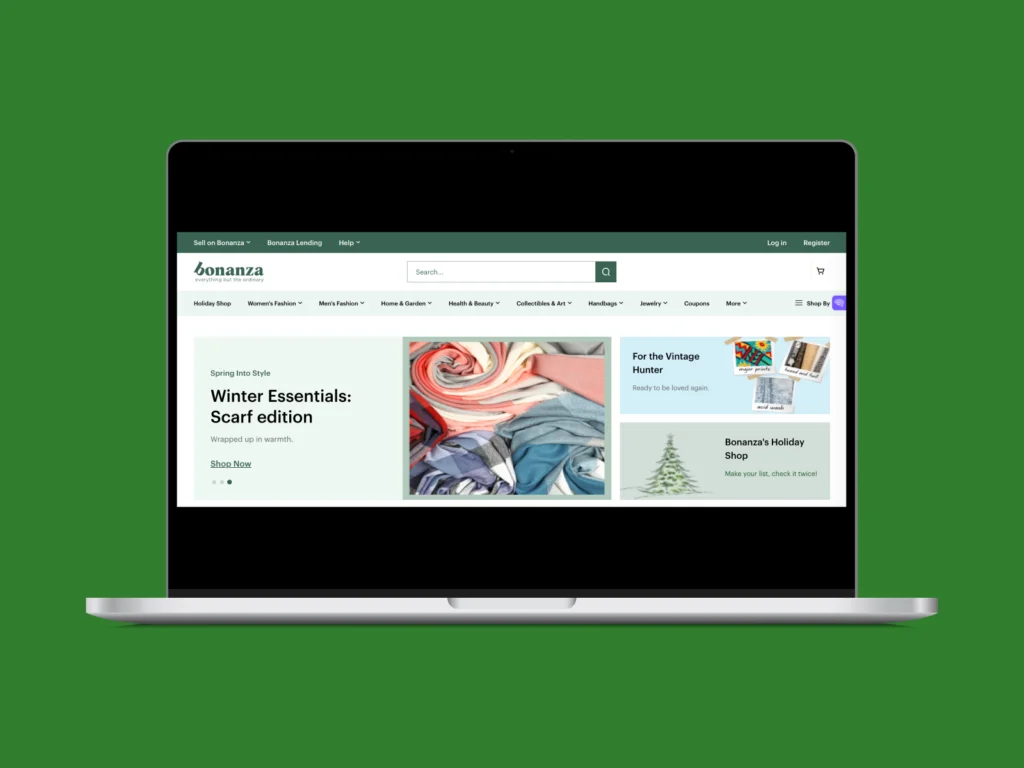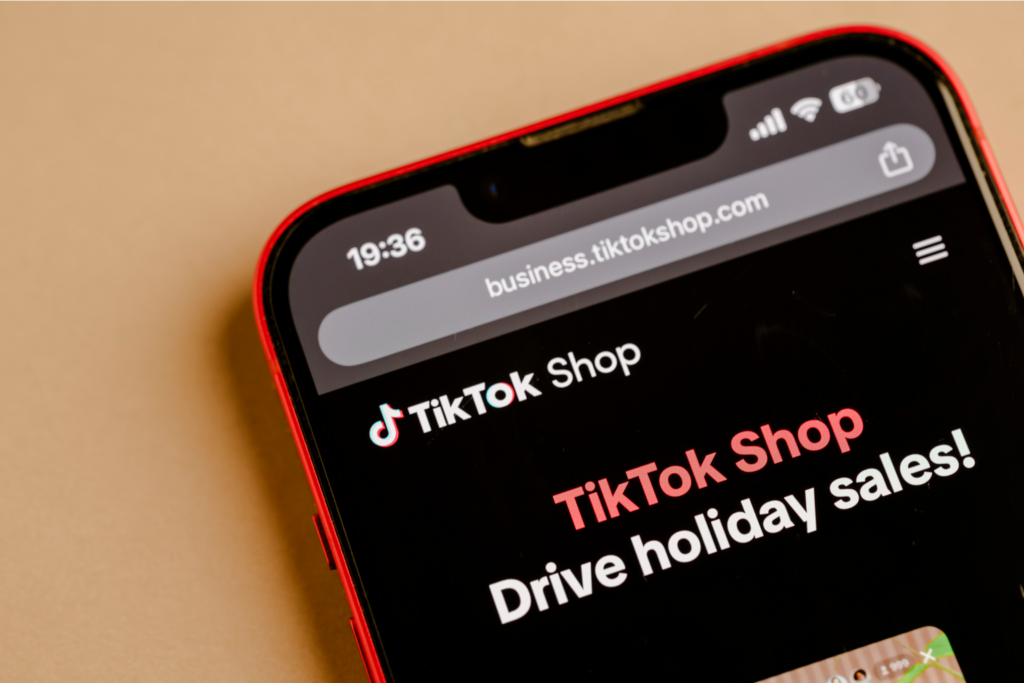Printify + your favorite platform = more sales!
Looking for the best eBay alternatives? Although the popular marketplace boasts 1.2 billion monthly visits, you might be interested in other platforms.
Whether targeting specific niches or broader markets, several other eCommerce marketplaces cater to diverse selling needs and might be a better choice for your business.
Let’s go over the best eBay alternatives for 2026.
Key takeaways
- Popular eBay alternatives, like Amazon, Etsy, and Facebook Marketplace, offer a broad audience reach and unique features tailored to different goals.
- Platforms like Poshmark for fashion and Decluttr for electronics cater to specific niches, offering a more targeted audience and the potential for more successful sales.
- Marketplaces like Bonanza allow easy integration with existing eBay listings, reducing the time and effort needed to transition to a different sales channel.
- Local selling platforms like Facebook Marketplace, OfferUp, and Letgo connect you directly with people nearby, making transactions quick and prices often negotiable.
- Understanding each eBay alternative’s features, benefits, and drawbacks will help you choose the best sales channel for the products you plan to sell.
Top eBay alternatives for sellers
Whether you want to find an online selling platform that allows you to create your own website or are tired of eBay’s fees, there are several great options.
Explore our curated list of the best eBay alternatives for online sellers, each tailored to different business goals.
Wish

It’s a particularly appealing eBay alternative for those who sell trendy, low-cost items.
Wish’s unique selling point lies in its highly visual platform, where eye-catching photos and competitive pricing can attract buyers looking for a good deal.
Pros:
- Huge user base
Wish has 11 million active monthly users, increasing your chances of making sales. - No upfront costs
There are no sign-up or monthly fees, so it’s easy to start selling on Wish without any initial financial investment. - Free listings
List products for free up to a certain threshold based on your Wish Standards tier.
Listing fees start at $0.15 and increase to $0.35 per active listing that exceeds your limit. - Marketing tools
Launch promotions like discounts, flash sales, and events to increase customer engagement and conversions. - Mobile-first
Wish offers a mobile app that ensures sellers can reach users actively browsing for deals from their smartphones.
Cons:
- High competition
The widespread popularity of Wish results in a highly competitive marketplace that can affect your profit margins. - High commission fees
Wish charges commissions based on a progressive structure, which can significantly impact profitability, especially for new merchants. - Low profit margins
The competitive environment and commission structure can limit your potential earnings. - Payment processing fees
Different payment methods carry extra costs that will lower your profit per transaction. - Shipping challenges
Managing shipping logistics and meeting Wish’s delivery expectations, especially for international orders, can be complex and costly. Wish customers frequently get frustrated over slow shipping.
Comparison with eBay:
Wish offers fixed-price listings but doesn’t have eBay’s auction-style options and flexibility when selling higher-ticket items.
Walmart Marketplace

The extensive reach and trusted brand name of the world’s leading retailer gives you access to millions of daily shoppers looking for a reliable shopping experience.
Pros:
- Huge audience
Walmart’s website attracted approximately 338.5 million shopper visits in March 2024. - No upfront costs
There are no setup, monthly, or subscription fees for Walmart sellers. - Brand trust
You’ll benefit from Walmart’s good reputation, enhancing the credibility and appeal of your products. - Walmart fulfillment services
Walmart offers storage, shipping, returns, and customer support services.
Cons:
- High competition
Walmart Marketplace is packed with established sellers offering goods at low prices. - Slow application process
You must submit a Tax ID, business address, product listings, and proof of success on other eCommerce sales channels. - Strict rules
Walmart enforces pricing regulations to protect customers against price gouging. If you fail to meet them, your products can get flagged and removed. - Low profit margins
You’ll need to list competitively priced products, and Walmart charges a 5% to 15% referral fee on each item sold. - Limited customization
There are fewer options to showcase your unique branding on product pages than on standalone eCommerce platforms.
Comparison with eBay:
While eBay relies heavily on peer-to-peer transactions carried out by individual merchants, Walmart is more suitable for dedicated commerce professionals.
Bonanza

It’s one of the best alternatives for existing eBay sellers who want to easily transfer their products and customer reviews to another eCommerce channel.
Pros:
- eBay integration
Save time by using Bonanza’s eBay integration to sync existing eBay listings, your Top-Rated Seller status, and customer feedback to Bonanza’s online marketplace. - Easy to use
Bonanza’s intuitive interface makes setting up a store, listing products, and managing orders simple. - No upfront listing fees
It’s free to list products on the marketplace. - Low transaction and final value fees
If you make below $1,000, Bonanza will charge $0.25 plus 3.5%. You’ll pay another 1.5% if you make more than that. - Strong Search Engine Optimization (SEO)
Bonanza’s platform is optimized for search engine visibility to help your listings rank higher in organic search results.
Cons:
- Setup fees
Bonanza requires a one-time, non-refundable $14.99 fee to create a new seller account. - Low reach
With around 1.2 million monthly visits, Bonanza has significantly less traffic than larger online marketplaces. - Few payment options
The marketplace only accepts PayPal and credit card payments. - Limited customization
The platform has fewer advanced features and tools for sellers compared to more established marketplaces. - Issues with product sync
You may need to batch-edit products imported from other sales channels to assign correct product categories.
Comparison with eBay:
While Bonanza offers lower selling fees and a more straightforward interface best suited for niche sellers, eBay’s massive user base and wide range of payment options make it a more powerful platform for high-volume merchants.
Amazon

When discussing the best eBay alternatives, one cannot ignore the powerhouse that is Amazon – one of the world’s most valuable brands.
Pros:
- Massive reach
With 3.2 billion monthly visits, Amazon gives you access to an enormous potential customer base. - Trusted brand
Amazon’s strong reputation can enhance your credibility and attract more customers. - Fulfillment by Amazon
Amazon offers to handle storage, packaging, and shipping, freeing you to focus on other aspects of your business. - Product diversity
Sell both new and used items on this online marketplace. - Advanced seller features
Streamline your operations at maximum efficiency with tools for inventory management, sales tracking, and advertising.
Cons:
- Intense competition
The large number of Amazon sellers creates a highly competitive environment, especially for popular products. - High fees
Unless you get the Professional plan for $39.99/month, you’ll pay a $0.99 selling fee for each item.
You’ll also pay referral fees ranging between 5% to 45% of the sale price. - Individual plan limitations
If you’re not on the Professional selling plan, your products can’t qualify as a Featured Offer, restricting visibility and the potential to make sales. - Strict seller policies
You’ll need to follow Amazon’s rules and standards. Otherwise, your account will be suspended. - Few branding options
Amazon prioritizes its own brand over individual seller branding, making it hard for you to stand out in the marketplace.
Comparison with eBay:
Amazon’s vast customer base and selling features make it a more attractive option for high-volume sellers. However, eBay’s lower fees and greater seller autonomy best suit niche-focused, smaller sellers.
Etsy

This popular online marketplace, which focuses on unique, vintage, and handmade items, fosters a vibrant community of artists and creative entrepreneurs.
Pros:
- Large audience
With 91.6 million active buyers in the first quarter of 2024, Etsy gives you access to millions of potential customers when selling online. - Niche focus
This platform attracts a dedicated community of buyers seeking handmade and vintage items. - Low listing fees
The platform’s fee structure favors small sellers of handmade or custom goods. - Easy to sell custom merch
Use our automated integration to offer print-on-demand products with no upfront costs. - Strong community
Etsy fosters a supportive community that values craftsmanship and creativity, enhancing seller credibility.
Cons:
- Multiple fees
While lower than some competitors, Etsy’s fees can accumulate, impacting profitability for high-volume sellers. - High competition
Popular niches on Etsy can be highly competitive, requiring sellers to differentiate themselves effectively. - Limited customization
Compared to standalone websites, Etsy stores have limited design and branding customization options, limiting sellers’ ability to create a unique brand identity. - Limited customer service
Sellers sometimes have difficulty getting timely support from Etsy’s customer service, which can be frustrating when dealing with urgent issues or disputes. - Unpredictable policy changes
Etsy occasionally updates its policies and fee structure, which can negatively affect your profitability.
Comparison with eBay:
Etsy excels in niche markets, particularly for creatives, while eBay offers broader product categories.
Craigslist
Created in the late 1990s as an online alternative to newspaper classified ads, this online market is ideal for those looking to sell locally without filing a lot of paperwork or submitting tax and insurance details.
Pros:
- High visibility
Craigslist is a highly visited website with over 180 million monthly visits, providing significant exposure for your listings. - Easy to use
Craigslist offers a simple interface that makes it easy for users to create and manage their product listings. - No fees for products
Craigslist is completely free to use and charges fees only for a few categories, like job listings and vehicles, making it highly cost-effective for sellers looking to maximize profits. - Wide variety of categories
Craigslist supports various categories, from real estate and jobs to personal items and services, allowing users to sell almost anything. - Negotiation flexibility
Buyers and sellers can negotiate prices and terms directly, fostering a more personalized and potentially favorable transaction experience.
Cons:
- No buyer protection
The seller is responsible for ensuring secure transactions, which increases the risk of scams or fraud. - Basic interface
The platform’s design and user experience may appear outdated compared to modern eCommerce sites, potentially deterring some people from using it. - Higher risk
Transactions on Craigslist involve direct interactions with strangers, heightening the risk of fraudulent activities or unsafe encounters. - No built-in payment processing
Sellers need to handle payment arrangements independently, which can complicate transactions and reduce buyer confidence.
Comparison with eBay:
Craigslist is one of the best eBay alternatives if you want to focus on localized selling. However, unlike eBay, it lacks security features. eBay charges for listings and sales, while Craigslist is mostly free, except for a few categories like job listings and vehicles.
Poshmark

This online marketplace is a terrific eBay alternative for reselling branded and quality clothing items. It provides an easy-to-use platform with many useful features for sellers.
Pros:
- Strong focus on fashion
Poshmark attracts a dedicated audience of buyers with a passion for fashion. - Easy to list and sell
The platform’s social elements – such as sharing and following – facilitate engagement and listing visibility. Poshmark also offers pre-paid shipping labels, making the process smooth. - Engaged community
Poshmark has a social media-like atmosphere with likes, shares, and comments. - Increased visibility
Scheduled virtual events allow sellers to promote products to a targeted audience, boosting exposure and sales.
Cons:
- High selling fees
Poshmark’s fee structure can reduce profit margins, especially for high-value items. It charges a $2.95 final value fee on all transactions below $15, with a 20% commission on anything higher. - Limited categories
The platform’s focus on fashion limits its appeal to sellers of other product categories. - Seasonal fluctuations
Poshmark’s sales trends can vary seasonally, requiring sellers to adapt their marketing strategies accordingly. - Hard to increase sales volume
Successful selling on Poshmark often requires consistent interaction and participation.
Comparison with eBay:
Poshmark is limited in categories, allows only the sale of previously owned fashion items, and charges significantly higher fees.
It’s possible to add fixed-price listings on both platforms, but Poshmark doesn’t offer auctions.
Facebook Marketplace
Facebook Marketplace makes it easy to sell online directly from your social media profile. With around 1 billion active monthly buyers, it appeals to sellers looking for local and nationwide reach.
Pros:
- Easy to use
Integration with Facebook’s platform ensures high exposure to active users on social media. - Low fees
There’s no product listing or monthly fee. There’s a 5% selling fee on each item, with a minimum of $0.40. and sell products without incurring fees usually charged by other eCommerce platforms. - Social media integration
Facebook Marketplace listings leverage social connections and recommendations, enhancing visibility. - Multiple shipping options
Sellers can choose between local pickup and shipping options, accommodating diverse buyer preferences. - Easy transactions
There are several ways to complete purchases and get paid on Facebook. Check out using Paypal or a credit card, or exchange cash in person upon delivery. If your customers pay on the platform, link your bank account so Facebook can deposit the money into your account after deducting their fees.
Cons:
- Minimal seller protection
Facebook Marketplace lacks robust seller protection mechanisms, opening the door for potential disputes or fraudulent transactions. - Variable buyer quality
Buyers on Facebook Marketplace may vary widely in terms of reliability and seriousness, affecting transaction outcomes. - Basic features
You won’t have a branded Facebook shop like you would on a dedicated eCommerce site. - Limited customer support
Sellers may encounter customer service and dispute resolution challenges, as support resources are more limited on smaller platforms.
Comparison with eBay:
Facebook Marketplace is great for local sales but lacks the global reach and selling tools that eBay is known for. It excels in pricing, as selling fees on this site are so low.
Depop
Depop targets younger audiences interested in fashion items, offering a visually appealing app interface and social media features for increased engagement.
Pros:
- Popular among young audiences
Depop appeals to a demographic interested in unique and trend-setting fashion pieces. - Simple and visually appealing
The platform’s design and user experience caters to a mobile-savvy audience, enhancing engagement. - Social media features
Depop integrates social elements that encourage interaction and product sharing among users. - Global reach
Sellers can reach a worldwide audience, expanding market potential beyond local limitations.
Cons:
- High competition
Depop’s popularity among fashion-forward users means sellers face significant competition for visibility. - Low brand recognition
Depop may lack the brand authority and trust associated with larger eCommerce platforms. - High selling fees
Depop charges a 10% total value fee for the combined retail and shipping costs. Either Depop Payments or Paypal charges a payment processing fee, the amount of which depends on your region. - Limited categories
Depop’s focus on fashion restricts its appeal to sellers of other product types or categories.
Comparison with eBay:
Depop is tailored to younger, fashion-conscious buyers, whereas eBay’s demographics show about 61% of buyers are in the 35-to-64-year-old range, with about 60% being men.
Decluttr
Decluttr is a platform specializing in electronic resales. It buys used electronics from sellers and resells them in its storefronts on Amazon and eBay.
Pros:
- Niche appeal
Decluttr focuses on a specific product category, attracting buyers looking for pre-owned electronics and media. - Easy to use
Sellers receive immediate offers and quick payment processing for their used electronics. Decluttr then sells the items to end customers, acting as a middleman and seller involvement. - Free shipping
The platform will cover shipping costs, reducing operational expenses for sellers. - No buyer negotiation
Decluttr sells electronics from big brands to the end customers, eliminating your involvement in the selling process and saving you valuable time.
Cons:
- Limited product categories
Decluttr’s focus on electronics and media, particularly branded and quality items in these categories, excludes sellers of other product types or categories. - Low payouts
Sellers may receive less than market value for items sold on Decluttr compared to direct sales. - Strict quality requirements
The platform imposes standards for product condition and quality, which sellers must meet to receive the quoted price. - No auctions
Decluttr’s selling model lacks the auction-style features and potential for competitive bidding found on eBay.
Comparison with eBay:
Unlike other platforms we’ve mentioned, Decluttr isn’t a marketplace but rather a business that buys used electronics and resells them elsewhere. It simplifies the selling process for those wanting to get rid of old electronics quickly but doesn’t offer the same price potential as eBay auctions.
OfferUp
OfferUp is a US-based online marketplace focusing on local transactions. It has an easy-to-use app and secure messaging for buyer-seller communication. Sellers post their items for sale, and buyers in their area can contact them to arrange a purchasing time and location.
Pros:
- No upfront costs
There are no listing fees on OfferUp, but there’s a 12.9% fee on the final sales price, with a minimum of $1.99. - Local focus
OfferUp simplifies selling for local transactions, enhancing convenience. - Secure messaging
The platform provides built-in messaging tools that facilitate safe and direct communication. - Instant payments
Sellers can receive immediate payment for transactions.
Cons:
- Limited to local market
OfferUp’s primary strength lies in local sales, potentially limiting reach compared to other eCommerce platforms. It’s possible to sell beyond your local area, but there will be shipping costs and a 12.9% fee charged by OfferUp. - High risk
Transactions on OfferUp rely on personal interactions and payment methods outside the platform, which can pose security risks. - High competition
Popular items may face significant competition from local sellers, affecting visibility and sales outcomes.
Comparison with eBay:
OfferUp is excellent for local, in-person sales, while eBay offers a wider audience and more secure transactions.
Letgo
Letgo is one of the best eBay alternatives for local sales, with no listing or selling fees. Simply list items and connect with buyers to arrange a pickup time.
Pros:
- Easy to use
Letgo’s intuitive platform simplifies listing and selling for local transactions. - No fees
Sellers can list and sell products on Letgo at no cost, maximizing profitability. - High visibility
The platform promotes high visibility for listings, ensuring products reach a broad local audience. - Easy communication
Letgo provides a buyer-seller chat tool for easy transaction management.
Cons:
- Possible transactional issues
Changes resulting from the merger with OfferUp could impact user experience and platform stability. - Limited to local markets
Letgo’s focus on local sales may restrict sellers seeking to reach a broader, national, or international audience. - Basic seller tools
The platform’s tools for managing listings and sales may be less advanced than those on larger eCommerce platforms. - High risk
Letgo’s free and open platform may attract users who are not seriously committed to completing transactions.
Comparison with eBay:
Letgo is best for quick, local sales, whereas eBay provides a global marketplace and auction features.
Niche-specific alternatives
Certain platforms like Poshmark and Decluttr cater to specific niches, making them ideal for sellers with specialized products. These niche platforms often provide a more targeted audience, resulting in higher conversion rates and more engaged shoppers.
Pros:
- Targeted audience interested in specific products.
- Higher conversion rates due to focused marketing.
- Specialized seller tools catering to unique needs.
Cons:
- Limited market reach beyond the niche audience.
- Higher competition within the specific category.
- Fewer options for diversifying product offerings compared to broader marketplaces.
Local selling platforms
Platforms like Facebook Marketplace, OfferUp, and Letgo are excellent options for those looking to sell locally.
These platforms simplify the selling process, allowing for quick and easy transactions without shipping hassles.
Pros:
- No shipping: Transactions are local, eliminating the seller’s responsibility for shipping and making it more cost-effective for both parties.
- Instant transactions: Buyers can often receive their purchases immediately after completing the transaction, enhancing customer satisfaction.
- Ease of use: Many local selling platforms have user-friendly interfaces and simple listing processes, making them accessible for new sellers.
Cons:
- Limited reach: Local selling platforms restrict sellers to a smaller, localized audience than global eCommerce platforms like eBay.
- Variable demand: Depending on the location and platform, demand for certain products may be inconsistent, affecting sales.
- Security concerns: Transactions may involve meeting strangers in person, raising safety and security concerns for both buyers and sellers.
Tips for picking the best alternatives to eBay for selling
![7 Tips for picking the best alternatives to eBay for selling Top eBay alternatives: [bp_year] Edition 1](https://printify.com/wp-content/uploads/2024/12/7-Tips-for-picking-the-best-alternatives-to-eBay-for-selling-1024x576.png)
- Define your market niche
Identify the specific category or niche your products fall into, like fashion, electronics, or handmade goods. Choose a platform that aligns with your target customer demographics and shopping preferences. - Evaluate fees and costs
Compare listing and transaction fees and any other costs associated with selling on each platform. - Review seller tools and support
Check the availability and quality of the platform’s seller tools, customer support, and resources. - Assess market reach
Evaluate the platform’s reach in terms of geographic locations and the size of its user base to ensure it matches your sales goals. - Check seller policies and protection
Understand the platform’s policies regarding seller protection, returns, and dispute resolution. - Explore integrations and ease of use
Look for platforms that integrate well with your existing systems and offer an intuitive user interface. - Explore marketing and promotions
Review the platform’s marketing, promotional, and analytics tools to help increase visibility and product sales. - Start with a trial or small scale
If possible, start with a trial period or list a few products to test the platform’s effectiveness before committing fully.
For more alternatives to other eCommerce platforms, check out our other guides:
FAQ
Amazon is often considered eBay’s biggest competitor due to its massive customer base and comprehensive selling tools.
Sellers are turning to platforms like Amazon, Etsy, Facebook Marketplace, Poshmark, and OfferUp as eBay alternatives. Each platform offers unique features tailored to different types of products and sales goals.
The best site depends on your selling needs. Amazon offers a larger audience, Etsy is fantastic for niche products, and Facebook Marketplace is excellent for local sales.
Conclusion
Exploring eBay alternatives allows sellers to tailor their approach based on specific product types and target markets.
Whether you prioritize broader audience reach, niche-specific focus, or local selling convenience, understanding each platform’s strengths and weaknesses is crucial.
Choose the platform that aligns best with your business goals, and start expanding your reach today.












